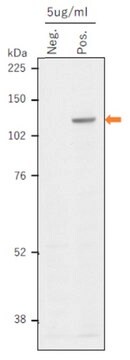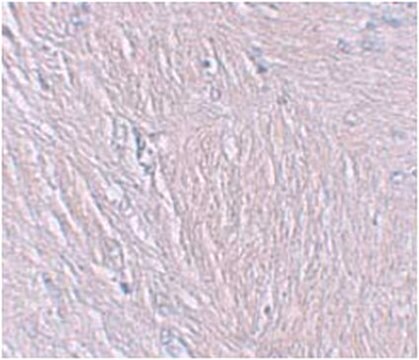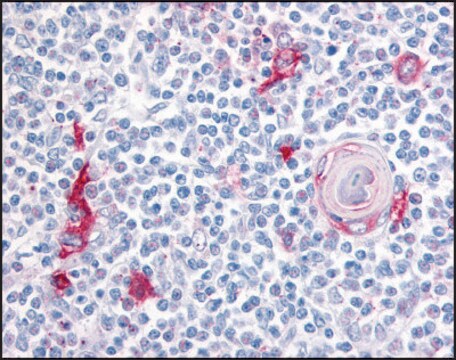MABC1795
Anti-phospho-TERT (Thr249) Antibody, clone TpMab-3
Sinónimos:
EC:2.7.7.49, HEST2, TP2, Telomerase catalytic subunit, Telomerase reverse transcriptase, Telomerase-associated protein 2
About This Item
Productos recomendados
origen biológico
mouse
Nivel de calidad
forma del anticuerpo
purified antibody
tipo de anticuerpo
primary antibodies
clon
TpMab-3, monoclonal
mol peso
calculated mol wt 127 kDa
observed mol wt ~127 kDa
purificado por
using protein G
reactividad de especies
human
envase
antibody small pack of 100
técnicas
immunofluorescence: suitable
immunohistochemistry: suitable
western blot: suitable
isotipo
IgG1κ
secuencia del epítopo
N-terminal half
Nº de acceso Protein ID
Nº de acceso UniProt
temp. de almacenamiento
2-8°C
Información sobre el gen
human ... TERT(7015)
Especificidad
Inmunógeno
Aplicación
Isotype testing: Identity confirmation by Isotyping Test.
Isotyping Analysis: The identity of this monoclonal antibody is confirmed by isotyping test to be mouse IgG1k.
Tested Applications
Immunofluorescence Analysis: A representative lot detected TERT in Immunofluorescence applications (Matsuda, Y., et al. (2022). J Pathol. 257(2):172-185).
Western Blotting Analysis: A 1:250 dilution from a representative lot detected TERT in Mitotic HeLa cells with RO3306 treatment (negative) versus mitotic HeLa cell samples (positive), where the positive control samples were obtained by IP using clone 10E9-2 to enrich hTERT ( Data courtesy of Dr. Kenkichi Masutomi, National Cancer Center Research Institute, Tokyo, Japan).
Western Blotting Analysis: A representative lot detected TERT in Western Blotting applications (Matsuda, Y., et al. (2022). J Pathol. 257(2):172-185).
Immunohistochemistry Applications: A representative lot detected TERT in Immunohistochemistry applications (Matsuda, Y., et al. (2022). J Pathol. 257(2):172-185).
Note: Actual optimal working dilutions must be determined by end user as specimens, and experimental conditions may vary with the end user.
Descripción de destino
Forma física
Reconstitución
Almacenamiento y estabilidad
Otras notas
Cláusula de descargo de responsabilidad
¿No encuentra el producto adecuado?
Pruebe nuestro Herramienta de selección de productos.
Código de clase de almacenamiento
12 - Non Combustible Liquids
Clase de riesgo para el agua (WGK)
WGK 1
Punto de inflamabilidad (°F)
Not applicable
Punto de inflamabilidad (°C)
Not applicable
Certificados de análisis (COA)
Busque Certificados de análisis (COA) introduciendo el número de lote del producto. Los números de lote se encuentran en la etiqueta del producto después de las palabras «Lot» o «Batch»
¿Ya tiene este producto?
Encuentre la documentación para los productos que ha comprado recientemente en la Biblioteca de documentos.
Nuestro equipo de científicos tiene experiencia en todas las áreas de investigación: Ciencias de la vida, Ciencia de los materiales, Síntesis química, Cromatografía, Analítica y muchas otras.
Póngase en contacto con el Servicio técnico








